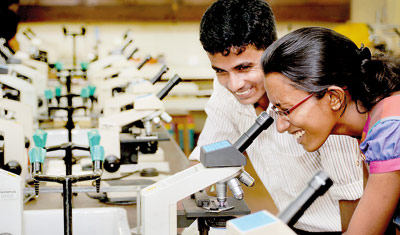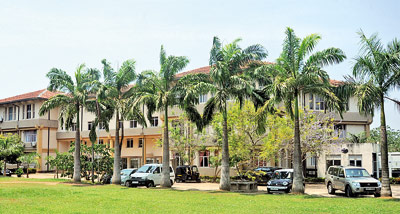‘Baby’ of Medical Faculties takes big strides
The Faculty of Medicine of the University of Kelaniya which more or less rose like a phoenix from the ashes of the North Colombo Medical College (NCMC) is 25 years old and to showcase its achievements over these two decades and five, its first International Scientific Conference will be held on April 7 and 8, with the inauguration on April 6.
| Marking 25 yearsWhile the ceremonial inauguration of the International Scientific Conference will be held with President Maithripala Sirisena as Chief Guest at the Hilton Colombo Residencies on April 6, the sessions over the next two days will be on home-ground at the Medical Faculty at Ragama.The inaugural Kelaniya Medical Faculty Oration on ‘Post-Traumatic Stress: The Sri Lankan Experience’ will be delivered by Consultant Psychiatrist Dr. Shehan Williams on April 6.Meanwhile, the Keynote Address on ‘Developing a research agenda in a less-than-research-friendly environment: The Ragama story’ will be delivered on April 7 by Prof. Janaka de Silva who is Senior Professor and Chair of Medicine at the Medical Faculty, Director of the Post-graduate Institute of Medicine, University of Colombo and Chairman of the National Research Council. |

All smiles: Medical students react most probably after spotting a bug under a microscope at the Parasitology lab. Pix by Amila Gamage
Numerous have not only been its achievements but also the recognition it has garnered, both locally and internationally, for major research that has emanated from within its portals, set amidst 35 acres to the rear of the North Colombo Teaching Hospital at Ragama.
It is last week, as buildings get a touch of paint and front columns are strengthened with mortar, that we meet the amiable Dean of the Faculty of Medicine, University of Kelaniya, Prof. Nilanthi de Silva, for a chat and a walkabout on campus where some students in small groups peer at copious notes while others have their eyes glued to microscopes in the Parasitology Laboratory.
To the query of what is “unique” about this Medical Faculty which is still a ‘baby’ compared to the ‘veterans and grandparents’, age-wise of those at Colombo (established in 1870) and Peradeniya (set up in 1962), the answer comes from Prof. de Silva without hesitation.
Not only does this Medical Faculty produce medical degree holders each year but it is the only higher education institution sending forth speech and language therapy experts armed with a Bachelor of Science. It is also the only Medical Faculty with its very own Clinical Trials Unit, a Disability Studies Unit which has now matured into the Department of Disability and a Molecular Medicine Unit (MMU).
Before looking at the high-points of achievement, we are taken back in time for a historical interlude.

Dean: Prof. Nilanthi de Silva
These premises were originally occupied by the NCMC, a private medical school set up in 1981. With the NCMC caught up in raging controversy and closure being imminent, its physical assets had been vested with the University of Kelaniya. It was in 1991 that the first batch of students recruited under the state admission criteria made Ragama their home under Founder-Dean Prof. Carlo Fonseka. Some of the NCMC Professors who fit the bill were also absorbed into the new state Medical Faculty while others were recruited through the usual state system.
“As the NCMC phased out, the state Medical Faculty phased in,” says Prof. de Silva who had joined the faculty in 1993 as a Lecturer and worked her way up as Senior Lecturer, then Professor and now Senior Professor in Parasitology, taking over the mantle of Dean in 2012.
The state Medical Faculty’s beginnings were humble, first occupying some dingy rooms and then gradually spreading across the campus as the NCMC put up its shutters, a glimpse into the not-too-distant past reveals. In its 25 years, the Medical Faculty has taken in 27 batches of students with 3,400 passing out with the Bachelor of Medicine, Bachelor of Surgery (MBBS) degree and serving the men, women and children across the country as doctors.
Explaining how the B.Sc in Speech and Language Therapy came about, Prof. de Silva says that in the late 1990s, a team arrived from the Institute of Child Health, Great Ormond Street Hospital in the United Kingdom to perform surgery on children who had serious cleft palate issues. Once the operations were done, however, follow-up could not be carried out for those children as there was no one trained in speech and language therapy. Seeing this ‘challenge’ as an opportunity, the Medical Faculty — which already had a Disability Studies Unit engaging in physiotherapy and community-based rehabilitation — launched a two-year fee-levying diploma course in this field.
Later, the diploma graduated to a four-year specially-designed state degree programme which included speech and language therapy as well as audiology, providing facilities for qualifying within Sri Lanka, for those who had secured such qualifications in the west or India earlier. The first batch of 35 B.Sc holders in Speech and Language Therapy passed out in 2013, with the country having 116 qualified in this field now, employed by the Health Ministry and private sector hospitals.
“These students are also trained to work in schools, helping to identify children with learning disabilities linked to speech. They can assess them and suggest who can join mainstream schools,” says Prof. de Silva.
There has been value-addition to the Medical Faculty by the Department of Disability Studies and the MMU, which is obvious on the day that the Sunday Times visits the campus.
Across the road from the Medical Faculty, two sets of parents have come with their little ones for evaluation and rehabilitation at the Department of Disability Studies. This is while senior staff members of the MMU — which is now making a mark in the arena of DNA testing for paternity as well as forensic fingerprinting in criminal cases such as murders and rapes — have just returned from court after giving evidence in a murder case.
Moving from the students to the academic staff of the Medical Faculty, Prof. de Silva points out that they have been encouraged to engage in high-quality research, “not doing research for its own sake”. These efforts have paid off, as research of value, ranging from worm infections to malaria diagnosis, snake-bite, yellow oleander (kaneru) poisoning to acute and chronic liver failure has been put on the world map by the Medical Faculty.

Plans for the future: Setting up of a specialty women’s hospital on the campus, with the Health Ministry
“Impactful and relevant research is what we have been engaged in. If at the end of research, peers ask ‘so what?’ it would be an exercise in futility. The proof that our research has been impactful comes with more than 100 citations in other eminent published research worldwide,” she says, adding that the secret of success has been hard work with inter-disciplinary links, supplementing and complementing each other. All of the 125 academics have jelled into a team that works well.
We have confidence about the expertise available in Sri Lanka. We have used international expertise but the premise has always been that through diligence, local expertise can reach the pinnacle, according to her, with the Clinical Trials Unit also contributing much towards the Medical Faculty’s significant achievements.
The 25 years have not been free of challenges and Prof. de Silva says one “small challenge” has been the distance between the university administration based at Kelaniya and the Medical Faculty administration based at Ragama. A bigger hurdle had been staff retention as turnover was high, which has now been surmounted while another has been to get the student body to keep its focus, while engaging in the idealism of youth.
Prevention of ragging is always on the minds of the academic staff, she says, citing a case of severe ragging in a private boarding last year where stern action in the form of a suspension was taken against the culprits. Regular are her meetings with the Students’ Union, as she believes that “no to ragging of freshers” should come from the senior students themselves to make it doable.
With the faculty population consisting of 60% girls and 40% boys, Prof. de Silva is also mentoring the girls to take their rightful place on committees so that their voices and issues would be heard and then could be dealt with.
The 60 foreigners, a majority from Bhutan, add a different cultural flavour to the student body and the share of monies from the fees levied from them that the faculty gets is utilized for the development of infrastructure and resources, she adds.
There are also the little touches which have gone a long way. Not concentrating on studies alone, the campus is teaching students the importance of greening the environment and conserving energy. Waste segregation has been implemented within the campus, while a compost plant, two biogas units and solar panels have also been established.
Looking into the future, Prof. de Silva says that they are discussing the setting up of a specialty women’s hospital on the campus, with the Health Ministry.
Another dream is the establishment of a day-care centre of excellence with state-of-the-art facilities for children with developmental disabilities under a multidisciplinary team.
Says Prof. de Silva with passion: “Then we can have training facilities for students and postgraduates and also for parents to enable them to give the best possible care to their children when they are at home.”


